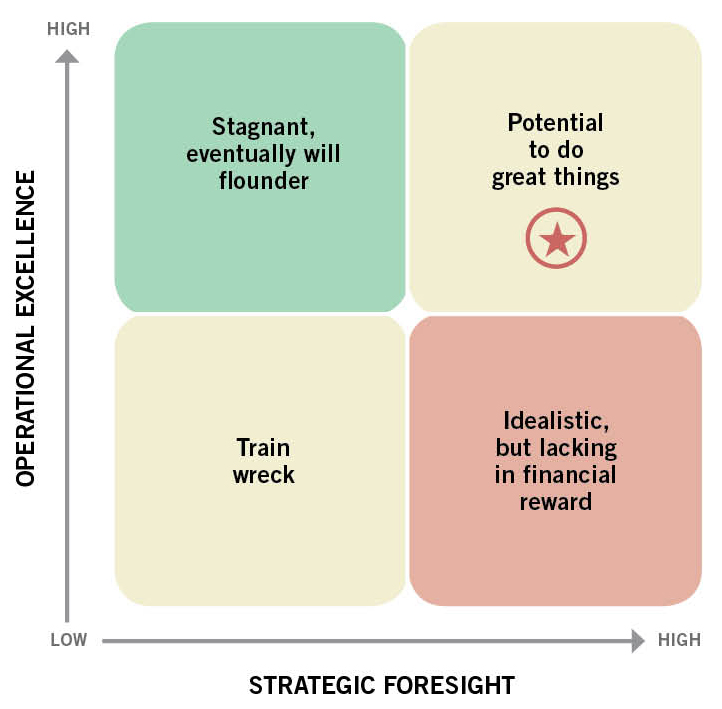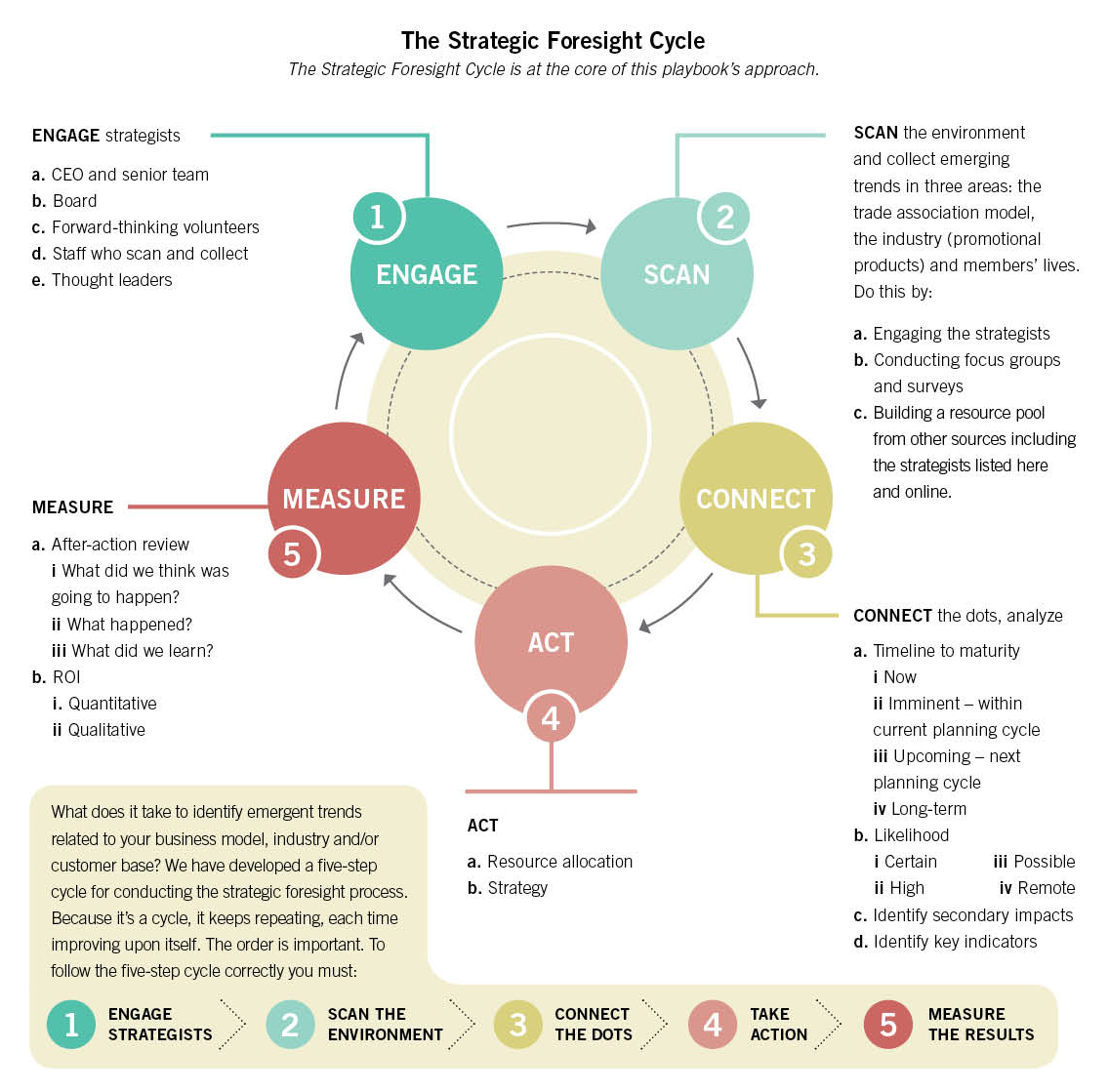Strategic Foresight

This article is an excerpt from the recently published PPAI Strategic Foresight Playbook.
Through strategic foresight, we peer through our customers’ eyes into their world, identify their unmet needs and see new solutions we can provide.
Whether yours is a small shop looking to grow beyond your current set of customers or increase your sales by understanding unmet needs, or a larger organization faced with ever-increasing demands for growth, strategic foresight can help. This approach brings you the answers you need straight from the front lines of your business, where the rubber meets the road and the salesperson meets the customer.
We all know that we have to keep our eyes on what’s next, whether it comes to us from the newspaper, a cocktail conversation, a thought leader’s analysis, internet news sources, social media, or even our own brain putting together new information in a moment of insight. But, how exactly do we do that?
Just like we can never stop marketing, we can never stop learning about our customers and their emerging unmet needs. The best of us have systems for making that learning happen. That’s where the idea for this playbook was born. As I have worked with over 100 CEOs and leaders of companies large and small, I have had the chance to see up close and personal what makes the difference between those whose businesses go up and down, rocked by trends, and those who are able to take any wind and turn it to their advantage.
It all comes down to regularly talking to smart people, scanning the environment, connecting the dots, trying new things, and learning from both successes and failures. And that’s what this book is about, providing you with easy-to-execute plays to make that happen.
You might ask, can you really take any change in the environment and use it to your advantage? The answer is always, Yes! In fact, when things change for the worse, a window opens that I call the opportunity window.
Every time your customers are dissatisfied, no matter what the reason, there is a short time when you can help them before others start generating solutions—that is your opportunity window. I have seen it happen often.
When customers are disgruntled, they desperately want things to be better—that is the definition of being disgruntled. This desire of theirs is a force you can harness. That is why I call it the opportunity window.
If you see the window coming, you can be ready for it and it can take your business forward in leaps and bounds. That’s where strategic foresight comes in. The plays in this book all lead to the same place: the territory of advantage for you and your business’s growth.
Strategic Foresight and Operational Excellence
Strategic foresight and operational excellence are two mutually reinforcing capabilities that every organization has at its disposal. It is worth investigating your organization’s synthesis of these two attributes. Imagine strategic foresight and operational excellence in a yin-yang relationship.
Your organization must be high-performing in its operations for you to find value in making strategic foresight a priority. Likewise, mastery of strategic foresight will increase your organization’s operational excellence.
How would you evaluate your operational excellence today? Do you have a solid foundation from which to seek opportunities for innovation? Here are a few questions you can ask yourself to gauge your strength:
- Is your organization able to sustain itself?
- Are you maintaining your profitability?
- Are you growing?
- Is your organization pooling together more and more resources?
Perpetuating this kind of operational excellence allows you to branch out and set your sights on the future. At this stage of productivity, operational excellence transforms into more than simple sustainability. It becomes your vehicle for strategic foresight— proactively innovating to influence or respond to an evolving market.
Because the two build on one another, it is important to gauge how you and your team are performing on both. What does it look like to be strong in one area and not the other?
A team or business with powerful strategic foresight but no operational excellence can be idealistic, unproductive and lacking in financial reward. A high-performing group with operational excellence but no strategic foresight can grow stagnant, and will begin to flounder as the market evolves. An organization lacking in operational excellence and strategic foresight is likely to be a train wreck. A team or organization that is strong in both areas has the potential to do great things.
Strategic foresight must be balanced with operational excellence. This balance ensures you are at least able to keep up in your own market.
There’s always the possibility that your team or organization can be put in a tight spot as it attempts to grow and innovate. Resources can be stretched thin, productivity can decline, and unforeseen events can influence your success. You may have a great plan, but without the right resources, leadership and ability to execute, your great plan won’t matter.
So, which comes first? Operational excellence must be assured before strategic foresight can take priority. If operational excellence stumbles, take time to reestablish your footing before you look ahead.

Innovation Is Necessary
But wait a minute. What’s wrong with maintaining your current situation? Why can’t an organization coast at its current level of success? Or just continue to grow by repeating what’s worked in the past to expand its customer base or member count? What kind of necessity is innovation? The answer might surprise you.
Innovation is truly a matter of survival. The nature of market growth implies that businesses will become obsolete if they don’t actively change along with their customers and industries. This kind of change can be reactive or proactive:
- Reactive: You observe your competitors innovating by creating new products, services, branding or business practices that cater to a new and unprecedented demand in the market. Your response is to jump on the bandwagon and pray you aren’t too far behind the crowd.
- Proactive: You analyze the market and pinpoint trends. As markets grow, you’re the first to know and the first to grow with them. You even anticipate market trends before they happen, innovating just in time for demand to reach critical mass. You position yourself as a pioneer of your industry.
Being reactive means you’re late to the game, scrambling to respond to shifts in the market that your competitors have already recognized and prepared for. There’s no innovation, only emulation. Now you’re racing against time and your competitors. Suddenly your organization is under threat.
Being proactive allows room for preparation. Your organization has the opportunity to gather the right resources and be the first in its field to address a new need. This is innovation. And it is critical to minimizing risk.
Of course, innovation requires that you do your homework. Identifying and analyzing market trends is a discipline in itself. Innovations of any kind can flop, as we often see in the real world. You’ll need to be able to gauge where the market is today and where it’s heading, with great accuracy and accountability. But that’s why you are interested in strategic foresight.
Strategic foresight is not a luxury of a flourishing organization; it’s an indispensable tactic to stay relevant and succeed.
Speed And Change Are Not Slowing Down
The shifts in the market that make innovation imperative are happening at a faster and faster rate.
It’s easy to buy into the mentality that your industry niche is growing or changing in a linear fashion, with each major shift proportional to the last. But we’re living at a time in which our experience of innovation skews our perception of its rate of change. The past 50 to 60 years have produced monumental changes in computing, global politics, agriculture, and every other branch of human endeavor. These shifts were happening, but were comfortably spread out, creating a false sense of stability in the rate at which civilization was changing. Most people fail to realize that these changes are not linear. They are not occurring in increments proportional to one another. It only seems that way from a particular perspective.
The data shows that the speed at which civilization is changing is exponential. This means that both the intensity and periodicity of innovation across all markets, all industries and all cultures are increasing with each increment. This is the difference between climbing 30 equidistant steps versus climbing 30 steps, with each step doubling in distance from the previous step. The first scenario is linear, and you arrive 30 units beyond where you started. The second scenario is exponential, and you arrive about one billion units beyond where you started. The difference is beyond dramatic.
Take a look at where we came from: we developed language, established agriculture, organized commerce, created the industrial revolution, invented the computer—each stage not only occurred in a shorter period than the stage before it, it also synthesized each of the previous stages, allowing society to grow more complex and capable.
Analysis of the data reveals that this combination of speed and change is everywhere. Compare computer processing power to the size of the circuitry. Graph it and you get an exponential curve. How about America’s GDP? It’s been growing exponentially, too. Private manufacturing? Exponential curve. Human life expectancy? Exponential.
Exponential trends can appear linear when seen from the perspective of the early stages, like driving toward mountains. As you approach the mountain you’re barely gaining elevation, if at all. But suddenly you reach a point where the terrain around you begins to climb steeply. Suddenly you’re halfway, or more, up the side of the mountain.
What we’re experiencing, and have been experiencing for the last 80 years, is the “knee of the curve.” Relative to the progress occurring over our lifetime, everything seems to be moving linearly. But not for long, and there’s only one direction we can go, call it what you will—up, out, further, more, beyond. We’re already seeing many innovations that appear to be exponential in nature. Artificial intelligence that drives the Internet of Things is one example. Many futurists predict this “explosive phase” will be in full swing between 2035 and 2050.

Strategic Foresight Is for Businesses of Every Scale
We want to encourage you to use these plays no matter the scale of your operation. Every strategy mentioned here has applications across the continuum of business ventures, from small mom-and-pop shops to the largest firms.
If your scale is small, there are many ways to downsize the plays in this text. If, for example, we suggest polling your customer base as one way to gather market intelligence, this could mean a simple conversation with several customers. It could also mean sending a short questionnaire to a large group of customers via social media—whatever seems realistic, yet actionable for your operational scale.
If you lead a larger venture—a multimillion- or multibillion-dollar organization that’s ready to up the ante— conducting strategic foresight is your most powerful investment. You can scale the plays up a couple notches. Ask yourself what your accumulated resources can accomplish (while still maintaining your operational excellence, of course). If we recommend you poll customers, distribute an online survey through your listserv tailored to specific demographics. Use your network to gain access to larger pools of data. The larger the scale of your plays, the larger your rewards will be.
Regardless of your scale, if you’re able to develop a capacity for strategic foresight and continually anticipate emerging trends, you’ve acquired an enormous asset.
Serving Your Industry
Let me remind you that you are part of something bigger. As you help your team and your organization, you help PPAI. Your market intelligence, your lessons learned, your success as a business—they can all be a valuable contribution to PPAI and the Association’s commitment to fostering large-scale and long-term growth for promotional product organizations. No matter how big or small your business is, when you share, you serve your industry.
---
What Is This Playbook?
The Strategic Foresight Playbook introduces the concept of strategic foresight and its application. It has been carefully designed to explain strategic foresight and provide plays, or activities, you can carry out to get the benefits of strategic foresight for yourself. Within the 70-plus pages are a collection of plays, activities for use in varying situations to help your company get ahead.
When we say strategic foresight, we mean the capacity to look at the future and spot emerging trends so you can proactively address them, either by preparing for the disruptions they will bring or by orienting yourself to be in the best possible position to take advantage of these trends. Either way, it’s guaranteed that the clearer you are about what’s coming, the more prepared you are to succeed in the days ahead.
How Does This Playbook Work?
In the first few chapters, we lay out some basic explanations so you get an idea of the territory of strategic foresight. Then comes the section marked Plays. Flip through them to find the strategies you believe are best suited to your organization—those most likely to catalyze, accelerate, or increase your likelihood of success Then read the overviews. They are purposefully kept brief so you can quickly scan and choose plays that seem best for you. At this stage, your goal is to follow the recipe. Just adhere to the instructions and experience the benefits they’ll bring to you and your organization.
The plays vary in application for different kinds of organizations. Sprinkled throughout are examples for three types of organizations. These examples are just a handful of ways to apply the plays. They are provided to make it easier to see how application might happen, not to limit your imagination.
How To Obtain A Copy
Download a free digital copy or purchase hard copies ($18 for PPAI members/$25 for PPAI associates) at www.ppai.org/strategic-foresightplaybook. To order 10 or more hard copies or to request a speaker on this topic, email playbook@ppai.org.
---
This article is copyrighted by Promotional Products Association International. All rights reserved, including the right of reproduction in whole or in part.
Seth Kahan is a recognized expert in innovation and strategy. He has served as a trusted advisor to over 100 CEOs, and has worked closely with the president of the World Bank, the director of the Peace Corps, and 100-plus trade associations and professional societies. Kahan has intensively studied strategic foresight. He helps leaders examine the future and provides them with expert guidance to help their organizations grow in today’s tumultuous business environment. His proven results in helping CEOs execute strategies for large-scale change, innovation and growth have earned him the designation of Thought-leader and Exemplar in Change Leadership from the Society for Advancement of Consulting® and the title of Visionary from the Center for Association Leadership. He has served as a member of the board of directors for the American Geophysical Union, the Columbia Lighthouse for the Blind and the Council of Better Business Bureaus. He founded Visionary Leadership® as the umbrella organization through which he works with forward-thinking executives. Seth@VisionaryLeadership.com, VisionaryLeadership.com.

